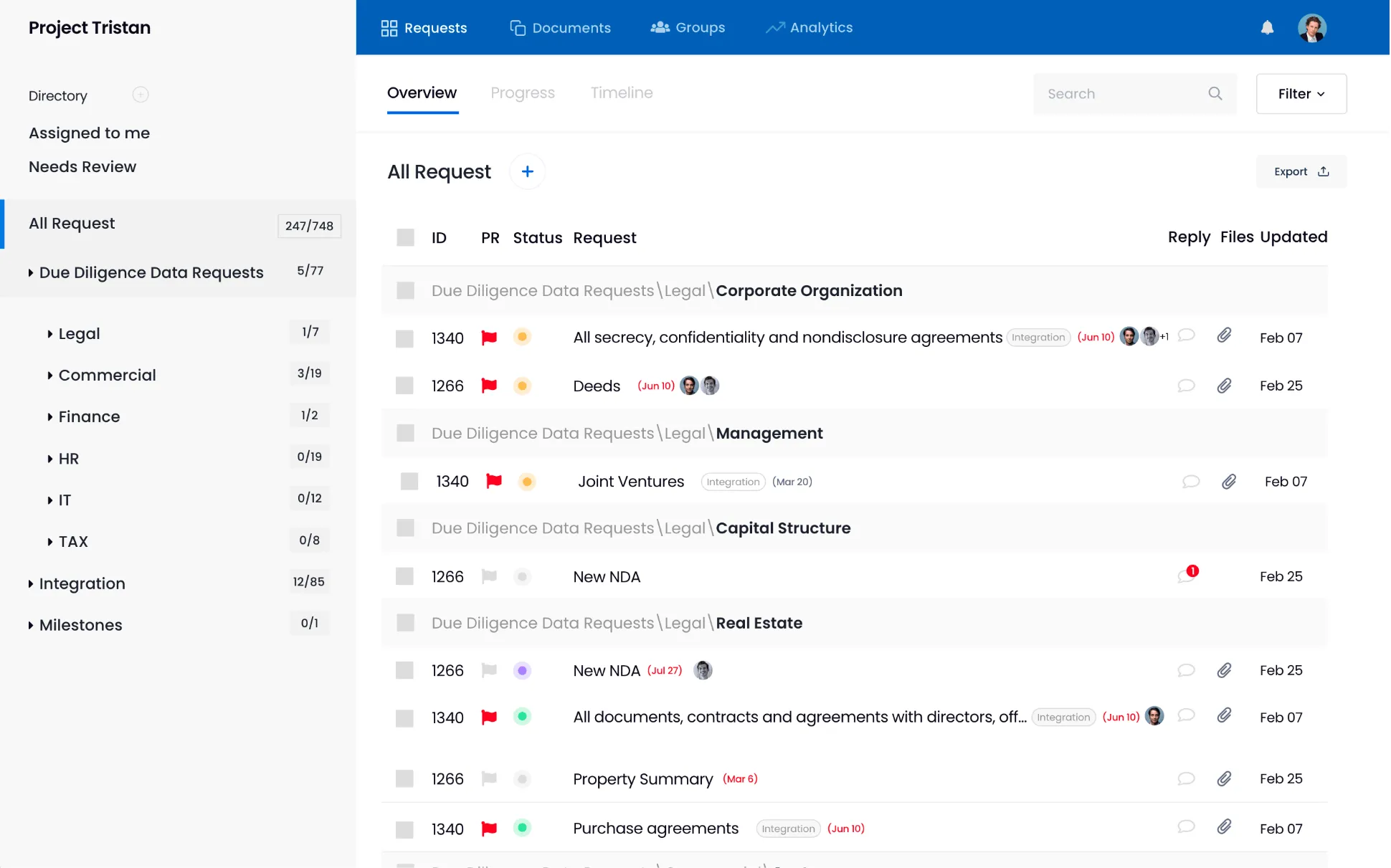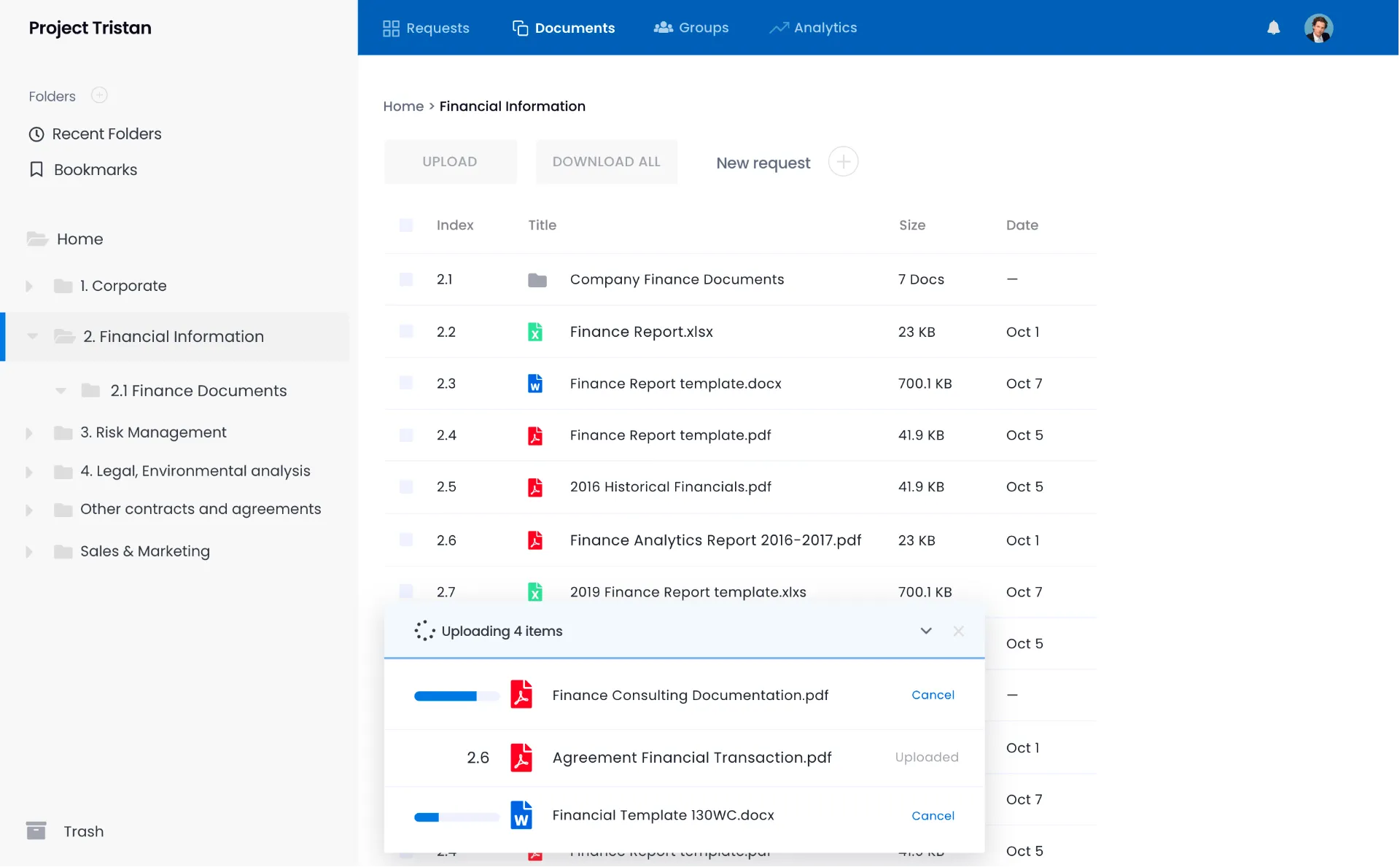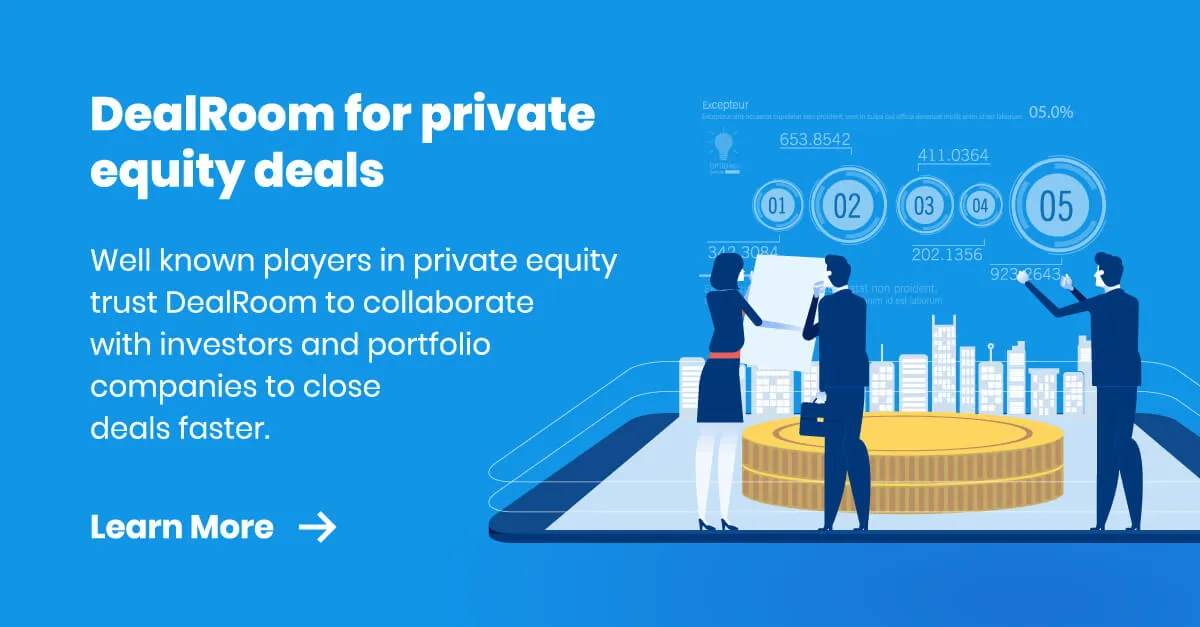Guide to Private Equity Deals and Process


According to private equity industry analyst Prequin, North American private equity firms are currently sitting on around $1 trillion ‘dry powder’ in addition to approximately $3 trillion in AUM.
Onlookers differ as to what this means for the mid-term consequences for private equity, but there is almost no argument on one point:
Private industry deals are sure to flow in the next 2-3 years.
DealRoom works with dozens of private equity firms on every stage of their deal process, from origination right through to due diligence and post-deal issues. This has given us a unique perspective on current movements in the industry as well as some more general insights.
In this article, we share some of those more general insights, aiming to give the reader a better understanding of what’s involved in a typical private equity deal.
What is private equity?
Private equity is a broad term used for investing in companies that are not publicly listed on a stock exchange. While most typically, the term refers to takeovers of companies, which are then structured as limited partnerships, private equity is also used as an umbrella term for investments such as leveraged buyouts (LBOs), venture capital (VC), and distressed investments.
The explicit goal of private equity investing is usually to extract value from the target companies that others haven’t seen.
While the initial evaluation of investment opportunities may seem to happen quickly, the materialization of private equity deals could take a few months or even a year.
The private equity due diligence process is a lengthy sequence of steps that involves a lot of research and information gathering, analytics, discussions, and assessments. (Check out our private equity due diligence playbook)
Institutional and accredited investors dedicate large sums of money for private equity investments. Holding periods of such funds are often long because investments require time to turnaround and exit.
However, private equity can be highly beneficial for many companies such as startups. It offers them advantageous alternative liquidity options when compared to conventional financing options.
How does private equity work?
The typical private equity process is usually some variant of the following:
- The private equity fund creates a strategy, usually based on a set of characteristics around the companies it will search out. These might include location, company size, financial position, industry vertical, or competitive advantage. The strategy would also include the size of the typical investment, the minimum investment by each limited partner (investor), their expected payback, and the payback period. This is put in documentation to pitch the fund to investors.
- The private equity fund uses this documentation to raise funds to invest, usually conducting some form of roadshow (referred to in private equity as ‘capital calls’) for the fund with pension funds, family offices, insurance firms, hedge funds, and even other private equity funds.
- The private equity firm manager and the team dedicated to the fund in question will begin searching for companies that fit the criteria for the fund’s strategy. The process of finding a single company can take months, with most private equity companies making contact with one company in forty or fifty potential targets.
- When a deal is agreed to acquire a minority or majority share in a private company, the private equity company begins implementing its strategy. This often involves cutting costs, or redirecting the company on a new strategy that they believe will generate enhanced growth. They will very often bring in more experienced managers than the newly acquired company has in place, ensuring that every part of the company’s operations are maximized in a bid to reach their target returns.
- The strategy will usually outline an exit plan for each acquisition, at which point the private equity fund will seek out buyers for their investment. A typical exit would occur after at least five years, by which point, cash flows have risen by a multiple of 2 to 3 times where they were at the time of the initial transaction, thanks to operational and market changes.
What are the phases of a private equity deal? (Process in details)

Here is a Structure of a Private Equity Deal
- ‘Sourcing’ and ‘Teasers’
- Signing a Non-Disclosure Agreement (NDA)
- Initial Due Diligence
- Investment Proposal
- The First Round Bid or Non-Binding Letter of Intent (LOI)
- Further Due Diligence
- Creating an Internal Operating Model
- Preliminary Investment Memorandum (PIM)
- Final Due Diligence
- Final Investment Committee Approval
- Final Binding Bid
- Signing the Deal
1. ‘Sourcing’ and ‘Teasers’
The beginning of the private equity deal structure is called ‘deal sourcing.’ Sourcing involves discovering and assessing an investment opportunity.
PE deals are sourced through various methods such as equity research, internal analysis, networking, cold-calling executives of target companies, business meetings, screening for certain criteria, conferences and conversations involving industry experts, and more.
A teaser is a one to a two-page summary sent by a financial intermediary about a company up for sale or private equity investment opportunity.
It does not mention the name of the seller, but only a brief description of the business, its products and services, and key financials. Companies often hire investment banks to confidentially attract top private equity firms and strategic buyers.
Investment banks can provide software solutions like investment banking data rooms for conducting a deal there.
Read also:
Deal Sourcing: A Beginner's Guide to M&A Deal Origination
How to Develop Effective Origination & Deal Sourcing Process
How to Have the Best Strategies for Advantageous Deal Sourcing
2. Signing a Non-Disclosure Agreement (NDA)
If a private equity firm is interested in the prospects from a ‘teaser,’ they will move forward by signing a Non-Disclosure Agreement (NDA).
Upon signing the NDA, the financial intermediary will provide the PE firm with a Confidential Information Memorandum (CIM). A CIM includes an investment thesis, financials, projections, and capital structure.
If an investment opportunity is sourced, the NDA is signed directly with the target company.
Consequently, the management of the target company will then provide confidential information regarding their business. In this stage of the private equity deal flow, the PE firm is granted with enough information to decide whether it will explore the investment opportunity any further.
3. Initial Due Diligence
In this phase of the private equity process, initial due diligence is conducted to form a better understanding of the target company.
It includes research and information gathering about the company and its industry.
Another huge piece of due diligence is estimating the return of investment according to the projections provided by the company’s management.
They may also get in touch with the investment bank to learn about the company from their perspective and potential debt financing options that are available for the acquisition.
Usually for these kind of work companies utlyze data rooms or special PE due diligence software like DealRoom which combines both functionalities for smooth diligence process. Here you can see the diligence requests examples:

4. Investment Proposal
After initial due diligence, the investment team prepares an investment proposal and presents it to their investment committee. The purpose of the first investment committee meeting often changes from one PE firm to another.
It can be a simple deal update or the initiation of a formal approval process. In the latter, the investment team is given the Green light to spend a certain amount of money on consultancy and other relevant expenses.
During this step as well, they may even submit a First Round Bid, which we will discuss next.
5. The First Round Bid or Non-Binding Letter of Intent (LOI)
During this stage of the private equity deal process, the investment team will provide the target company with a non-binding letter of intent (LOI) for the transaction.
This is the under specific criteria provided to them by the target company’s management. Often, a valuation range is mentioned rather than a specific amount. The target company and its advisors will then choose a few bids and move on to the next round in the auction process.
Some key points that are taken into consideration here include:
- Purchase price (or range)
- Post-acquisition capital structure
- Time needed to provide a binding offer
- PE firm’s experience and expertise
- Value creation strategy
- Credibility of the offer
- Compatibility with the submitting firm’s management team
6. Further Due Diligence
The private equity due diligence framework gets back to work again.
Here, the sellers provide more confidential information.
Many companies utilize virtual data rooms (VDRs) or DealRoom with built-in data room to collaborate, assign tasks, and exchange information.
This information includes but is not limited to:
- The company’s legal and organizational entities
- Operations records
- Board reports including meeting minutes
- Property agreements
- Documentation related to intellectual properties
- Financial information including audited and unaudited financials
- Employee details
- Employee agreements
The PE investment team conducts due diligence by reviewing the files in the data room.

They will have follow-up calls with the management of the target company for further assessments and clarifications.
On top of that, they will also brainstorm critical post-acquisition issues that the acquiring firm may face short- and long-term.
7. Creating an Internal Operating Model
An operating model is a highly detailed revenue and cost breakdown.
It takes key drivers of the target business and assumptions into consideration. Key drivers may vary greatly from deal to deal. Some common ones include:
- Raw material costs
- Volume
- Price
- Number of customers
- Renewal rates
- Fixed vs. variable cost structure
Investors utilize this model to estimate the financial performance of the target firm. This gives the PE firm’s decision-makers a clearer picture of the major factors that drive return for the acquisition.
8. Preliminary Investment Memorandum (PIM)
The Preliminary Investment Memorandum (PIM) is a 30 to 40-page document that summarizes the investment opportunity to the PE firm’s investment committee.
The Preliminary Investment Memorandum usually consists of the following sections:
- Executive Summary -- important details such as the transaction, background, deal team recommendations, and the investment thesis.
- Company Overview -- the target firm’s description, products and services, history, suppliers, competitors, customers, organizational structure, and biographies of the key management, and more.
- Market & Industry Overviews -- market growth rates and trends.
- Financial Overview -- past and projected income statements, balance sheets, and analytics of cash flow.
- Valuation Overview -- analytics about the company, M&A transactions, LBO, DCF, etc.
- Risks & Key Areas -- probable risks to the industry and business that were identified by due diligence.
- Exit Details -- options when it comes to an investment exit and its timing.
- Proposed Project Plan -- recommendations to the committee on how to proceed with the project based on a valuation range and a budget approved by the investment committee.
Deal teams usually perform only the initial due diligence up to this stage due to high costs. Further legal due diligence is carried out later in the private equity due diligence framework.
9. Final Due Diligence
Once the investment committee approves the PIM, the PE deal team will then perform all the remaining and final due diligence. The investment team will dedicate their time only for the particular project at this stage.
Other PE projects will be either sidelined or delegated to other professionals within the firm.
In this stage of the private equity investment process flow chart, the deal team typically interacts with the investment bank and the management of the target company on a daily basis.
They will send requests to the target company to address any outstanding issues such as visit requests, calls with sales personnel, non-executive management, customers, and suppliers.
During this time, the investment team will manage the consultants on various streams of the due diligence process such as financial, commercial, and legal.
Furthermore, they will start negotiating with the banks about debt financing options, aiming to secure the best debt terms with a group of banks.
It usually takes between three to six weeks for the due diligence process in private equity from the First Round Bid to the Final Binding Bid.
10. Final Investment Committee Approval
Once all the steps in the private equity due diligence process are completed and the investment team is comfortable moving forward with the deal, a Final Investment Memorandum (FIM) is created.
The FIM addresses the further due diligence carried out by the deal team and its consultants from the time of creating the PIM, especially highlighting any key issues pointed out by the investment committee.
Furthermore, the deal team will recommend a specific valuation to acquire the target company. The valuation will be either approved or rejected by the investment committee.
11. Final Binding Bid
If the FIM is approved by the investment committee, the deal team will proceed by sending a Final Binding Bid (or a Final Round Bid) to the target company.
This bid includes a final buying price, financing documents from investment banks, and preliminary merger agreements. The preliminary merger agreements will be discussed later with the seller’s lawyers.
The seller and their advisors will then spend at least a few days considering the bids they receive and ultimately choose a winning bid.
12. Signing the Deal
Once the seller along with its investment bankers and advisors pick a winning bid, they will work exclusively with that preferred party to sign transaction documents and contracts.
A Purchase Agreement (or Merger Agreement) and other documents will be created after negotiations between the lawyers of the buyer and seller.
The private equity investment cycle
The private equity investment cycle refers to the period in which the private equity fund manages the company. A typical holding period is three to five years, with the long-term average holding period for private equity funds being around four years.
However, the ‘harvest period’ - that is, the time at which the companies in the fund are divested and funds returned to investors - may be extended beyond five years if the conditions to sell are not suitable (or the business is performing so well that the private equity fund decides to continue to benefit from its cash flows).
How private equity deals are funded
Private equity deals can be funded by almost every conceivable combination of private capital. As mentioned at the outset, the ultimate source of the funds could be anything from a university endowment fund to a rich aunt with an appetite for high returns on her investment.
Ultimately, all of this cash makes its way into the private equity fund, which is then used to pay for the investments. A key point to note here is that the limited partners - the endowment fund, the rich aunt, and others - hand control of the investments over to the general partners, the private equity manager.
Thus, his or her reputation depends on how well they manage the funds invested.
Examples of private equity deals
There is an extraordinary number of private equity deals being closed on a daily basis, particularly when deals in venture capital, growth capital, distressed assets, and the rest are taken into account.
For this reason, we decided it would be worthwhile to look at examples of two different kinds of private equity deals - a leveraged buyout and a venture capital deal - to understand the dynamics of private equity from a couple of different standpoints.
The leveraged buyout example: Blackstone acquires Hilton Hotels for $26 billion, 2007
If anyone ever doubted the blurred lines between M&A and private equity, it is worth noting that Blackstone started life as an M&A advisory firm in 1985, using its advisory fees to move into private equity.
In 2007, Blackstone used a leveraged buyout to purchase Hilton Hotels. Blackstone leveraged almost 80% of the total amount, ($20 billion), to take control of the famous hotel chain. It reduced operational inefficiencies at Hilton, sold underperforming assets, and reinvested in good locations.
When it sold the asset in 2018, it did so at a profit of around $14 billion. And all by initially just using $5.6 billion of its own equity.
Read our article on largest and most recent leveraged buyout examples
Venture capital example: SoftBank acquires 34% Alibaba for $20 million, 2000
In the venture capital branch of private equity, investors are looking for young, sometimes non-profitable companies with massive potential.
The acquisitions are almost never for anything other than a share of the company, on the basis that the equity investment in those fast-growing companies will lead to holding a share in a much larger, profitable company a few years down the road.
That was the bet that Softbank took with a young Chinese e-commerce store called Alibaba in 2000. When Alibaba listed launched its IPO nearly twenty years later, it achieved a valuation of $231 billion - making Softbank’s share worth a cool $60 billion.
Final thoughts
The process from evaluation to completion of a new private equity investment venture can be lengthy and exhausting.
While the steps carried out in the private equity due diligence process may vary from one private equity firm to another, most key steps mentioned above remain the same. This is due to their importance in ensuring a prosperous and successful private equity investment.

Get your M&A process in order. Use DealRoom as a single source of truth and align your team.








.png)
.png)
.png)
.svg)

.svg)
.png)


